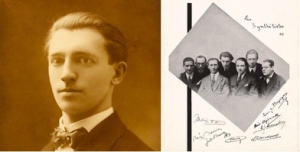#214– August 28, 2023

Maurice Schoemaker and The Synthetists
I.Prelude
https://www.youtube.com/watch?v=Kn2ylvQJeoc
II.Scherzo
https://www.youtube.com/watch?v=cCwqmZ_Vu70
III.March
https://www.youtube.com/watch?v=S_nE-97Ohfc
IV. Nocturno
https://www.youtube.com/watch?v=Bald9lDCaTM
V.Finale
https://www.youtube.com/watch?v=gff367Ovlgw
Brueghel Suite, by Belgian composer Maurice Schoemaker is our Composition of the Week.
During the coming summer weeks, we are presenting Belgian literature for wind orchestra by Paul Gilson and a group of his students who, in September 1925, joined their creative forces to form the first group of composers in Belgian history, called the Synthetists.
The music they produced constitutes an unavoidable historical heritage of the early 20th century.
This fresh and imaginative repertoire, of great artistic quality, remains curiously and unjustly unknown.
Maurice Schoemaker wrote a version for Wind Orchestra of his Symphonic Variations, later called the Brueghel Suite in 1928, and was dedicated to Arthur Prevost, the conductor of the Belgian Guides. The original music from Symphonic Variations was itself the reworked ballet music by Schoemaker called “Le Roi Boit”.
“The Brueghel Suite is not a sound or musical reproduction of paintings by Bruegel such as Mussorgsky in Pictures at an Exhibition. Schoemaker devises a musical poem in which he expresses the emotions that the paintings evoke to him. Typical in his orchestral music and in this suite, are the programmatic, descriptive character and subtle lyricism.” (Program notes by editor.)
Brueghel Suite is scored for large Symphonic Band, including Contrabassoon, Double Bass, Harp and 5 percussion parts.
It is structured in 5 movements:
I.Prelude, II.Scherzo, III.March, IV.Nocturne and V.Finale
It has a duration of about 18’ minutes.
The music is available at Band Press, Belgium.
According to Francis Pieters, former WASBE President and remarkable scholar of European wind music, Schoemaker is the man behind the creation of the Synthétistes group.
Schoemaker describes his project as follows:
“Casting all the elements of today’s music into firmly specified forms: in other words, synthesizing.” (Quoted in « Eux aussi ont écrit pour orchestre à vent », pag. 103)
Maurice Schoemaker was largely self-taught but took private lessons in orchestration and composition with Gilson. He had already composed several works before the First World War, and in 1925 he was the oldest in the group when he joined The Synthetists. He remained faithful to his own style, and composed his first works in a conservative, traditional late-Romantic style that referred to that of his teacher.
Other works for winds include:
- Feu d’artifice (1924), for wind orchestra.
- Sinfonia da Camera (1929) for saxophone quartet and wind orchestra
- Deux Fantasques (1930)
- Scènes Flamandes (1934)
- Pièce Concertante (1939) for trombone and wind orchestra
- Variations pour cor et orchestre (1941)
- Concerto pour Basson et Orchestre (1947)
- Scherzo (1947)
- Ouverture Romane (1947)


